
This resource contains a list of questions for students to answer in argumentative or persuasive essays.
- Subject:
- English Language Arts
- Material Type:
- Activity/Lab
- Provider:
- New York Times
- Author:
- The Learning Network
- Date Added:
- 04/23/2017

This resource contains a list of questions for students to answer in argumentative or persuasive essays.
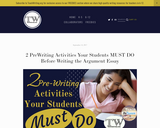
This resource details prewriting strategies for students to employ when writing arguments.

This resource from the New York Times contains 301 prompts and connections for student discussion and arguementative writing.
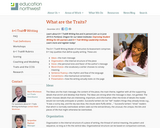
This article details the key qualities of strong writing.

This resource accompanies our Rethink 7th Grade ELA course. It includes ideas for use, ways to support exceptional children, ways to extend learning, digital resources and tools, tips for supporting English Language Learners and students with visual and hearing impairments. There are also ideas for offline learning.

Students will watch a video of the blame scene from Titanic the musical. They will review the lyrics and make a preliminary determination about who they think is most to blame for the large loss of life on Titanic. Students will them look at the poster timeline created in Titanic 3 or they can scan their text to find examples that support their claim about who is most to blame. Finally, students will complete some online research to find evidence to support their claim. This will all be presented in a Glog on Glogster.

This parent guide supports parents in helping their child at home with the 7th grade ELA content.

Seventeen-year-old best friends dream of becoming light-weight boxing champions of the world. They train together until they find out that they will meet in the ring to determine who will fight in a championship tournament. In this CCSS lesson, students will explore this story through text dependent questions, academic vocabulary, and writing assignments.

In this lesson, students will compare/contrast the information in their textbook about Andrew Jackson to political cartoons of the era. Students will identify symbols, allusions and stereotypes used in these cartoons and infer the intended message and tone of the Jackson era cartoons. Students will also identify any biases in the cartoons and check for historical accuracy, and then formulate their own opinion about the Jackson Administration. As a culminating activity, students will write an opinion essay that articulates their personal stance on Andrew Jackson’s character, using proper writing conventions.

In this lesson, students will discover a policy within their school or district that is important to them and that they'd like to change. They will conduct an investigation of the policy in question and write a letter with their claim, results, and recommendation to the appropriate audience.

In this lesson, the students will read and reread the passage closely and focusing their reading through a series of questions and discussion about the text, students will be able to understand the structure and purpose of this particular soliloquy and how it delves into universal themes regarding the human condition.

In this CCSS lesson, students will explore this story through text dependent questions, academic vocabulary, and writing assignments. Printable text files included.

Birth of a Colony explores the history of North Carolina from the time of European exploration through the Tuscarora War. Presented in five acts, the video combines primary sources and expert commentary to bring this period of our history to life. The opening segment describes the forces that motivated European exploration and colonization of the New World. Explorers and colonists encountered native peoples with agricultural lifestyles, strong communities, and respect for the land. These Indian communities saw themselves as part of nature, and they lived in harmony with the natural world. Their spiritual practices, such as the Green Corn Ceremony, reflected this worldview. The Europeans came to the New World primarily in search of land and riches. With two such different cultural viewpoints, clashes were inevitable. This teacher's guide includes a strictly social studies lesson and a complementary ELA lesson (writing assignment).

The lesson includes an exploration of the genre of letters to the editor, a review of persuasive writing structure and letter format, and an emphasis on multi-draft writing. The lesson focuses on the character Roy Eberhardt from Carl Hiaasen’s Newbery Honor Book Hoot for its examples. Students can complete the activity for any book that they have read.
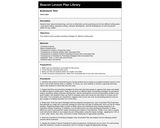
In this lesson, students will learn about brainstorming and how to effectively use this prewriting tool for four different writing tasks - persuasive writing, expository writing, character development, and the development of vivid and precise details for any subject.

Students become novice lexicographers as they explore recent new entries to the Oxford English Dictionary (OED), learn the process of writing entries for the OED, and write a new entry themselves. Students will follow up their entry with a persuasive essay and a competition in which the strongest contender for the title of New Word is chosen. Extensions will offer students a chance to evaluate old lists of "new words" and discuss the power dynamics of dictionaries.

This inquiry provides students with an opportunity to explore how words affect public opinion through an examination of Harriet Beecher Stowe's novel Uncle Tom's Cabin. Students will investigate historical sources related to the novel and reactions of people in the North and South in order to address the compelling question "Can words lead to war?" The final summative assessment asks the to make an argument about the impact of the words in Uncle Tom's Cabin.
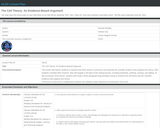
Students research the three tenets of cell theory and describe the scientific evidence that supports this theory. After students complete their research, they will engage in all steps of the writing process, including prewriting, outlining, revising, and editing. At the conclusion of the lesson, students will create a three-paragraph argumentative essay to examine the cell theory and the scientific evidence that supports this theory.

As the narrator sends her son Laurie off to kindergarten, she fears that her sweet child may be thrown out of school. In this CCSS lesson, students will explore this story through text dependent questions, academic vocabulary, and writing assignments.
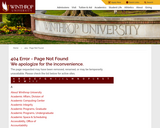
This two-page handout details the elements of an argumentative essay.